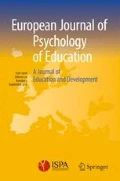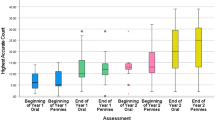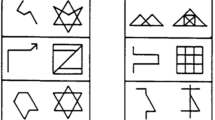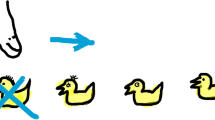Abstract
The aim of this study was twofold. First, it evaluated the developmental changes on frequency of use, efficiency, and choice of counting strategies from childhood to adulthood. Second, it determined the adaptation of the counting strategies to the structural features of the task. Participants in seven age groups ranging from 5-year-old to adulthood were asked to count dots in arrays varying on size, arrangement, density and size of the subgroups. The nature of the strategies used and their efficiency, i.e. speed, accuracy and rate of manual pointing, were recorded using the overt behavior technique. The developmental pattern of results for the four main strategies, counting by ones, by ns, addition and multiplication, was in line with Siegler’s overlapping waves model. The structural features affected the use of the strategies since 13 years, except for the multiplication strategy. Finally, intra- and inter-individual variability in strategy showed a monotonous increase with age. Implications for understanding the development of counting skill are discussed.
Résumé
Le but de cette étude était, tout d’abord, d’évaluer les changements développementaux affectant la fréquence d’utilisation, l’efficacité et le choix des stratégies de comptage de 5 ans à l’âge adulte. Cette étude cherchait également à déterminer le degré d’adaptation de ces stratégies de comptage aux caractéristiques de la tâche. Les participants comptaient des collections de points variant en taille, disposition, densité et taille des sous-groupes. La nature des stratégies ainsi que leur efficacité (vitesse, précision et utilisation du pointage manuel) ont été recueillis à partir des performances faites à haute voix (overt-behavior technique). Le développement des quatre principales stratégies étaient compatibles avec le modèle de Siegler (1996). Les caractéristiques de la tâche affectaient l’utilisation des stratégies, mais seulement à partir de 13 ans. De plus, la variabilité intra- et interindividuelle augmentait continuellement avec l’âge. Ces résultats éclairent d’un jour nouveau l’évolution des activités de comptage.
Similar content being viewed by others
References
Alibali, M.W., & DiRusso, A.A. (1999). The function of gesture in learning to count: More than keeping track.Cognitive Development, 14, 37–56.
Anderson, J.R. (1983).The architecture of cognition. Cambridge: Harvard University Press.
Anderson, J.R. (1993).The rules of the mind. Hillsdale, NJ: Erlbaum.
Aoki, T. (1977). On the counting process of patterned dots.Tohoku Psychologica Folia, 36, 15–22.
Beckwith, M., & Restle, F. (1966). Process of enumeration.Psychological Review, 73, 437–444.
Camos, V. (in press). Coordination process in counting.International Journal of Psychology.
Camos, V., Barrouillet, P., & Fayol, M. (2001). Does the coordination of verbal and motor information explain the development of counting in children?Journal of Experimental Child Psychology, 78(3), 240–262.
Camos, V., Fayol, M., & Barrouillet, P. (1999). L’activité de dénombrement chez l’enfant: Double-tâche ou procédure? [Counting in children: Dual-task or procedure?].L’Année Psychologique, 99, 623–645 [in French].
Case, R. (1985).Intellectual development: Birth to adulthood. New York: Academic Press.
Church, R.B., & Goldin-Meadow, S. (1986). The mismatch between gesture and speech as an index of transitional knowledge.Cognition, 23, 43–71.
Dehaene, S., & Mehler, J. (1992). Cross-linguistic regularities in the frequency of number words.Cognition, 43, 1–29.
Frick, R. W. (1987). The homogeneity effect in counting.Perception & Psychophysics, 41, 8–16.
Fuson, K.C. (1988).Children’s counting and concepts of number. New-York: Springer-Verlag.
Gelman, R., & Gallistel, C.R. (1978).The child’s understanding of number. Cambridge, MA: Harvard University Press.
Graham, T.A. (1999). The role of gesture in children’s learning to count.Journal of Experimental Child Psychology, 74, 333–335.
Gréco, P. (1962). Quantité et quotité. In P. Gréco & A. Morf (Eds.),Structures numériques élémentaires (Etudes d’épistémologie génétique, Vol. XIII) (pp. 1–70). Paris: Presses Universitaires de France.
Halford, G.S. (1993).Children’s understanding: The development of mental models. Hillsdale, NJ: Erlbaum.
Lemaire, P., & Siegler, R.S. (1995). Four aspects of strategic change: Contributions to children’s learning of multiplication.Journal of Experimental Psychology General, 124, 83–97.
Mandler, G., & Shebo, B.J. (1982). Subitizing: An analysis of its components processes.Journal of Experimental Psychology: General, 111, 1–22.
McGilly, K., & Siegler, R.S. (1989). How children choose among serial recall strategies.Child Development, 60, 172–182.
Miller, K.F., & Stigler, J.W. (1987). Counting in Chinese: Cultural variation in a basic cognitive skill.Cognitive Development, 2, 279–305.
Newman, R.S., Friedman, C.A., & Gockley, D.R. (1987). Children’s use of multiple-counting skills: Adaptation of task factors.Journal of Experimental Child Psychology, 44, 268–282.
Pascual-Leone, J. (1988). Organismic processes for neo-piagetian theories: A dialectical causal account of cognitive development. In A. Demetriou (Ed.),The neo-piagetian theories of cognitive development: Toward an integration (pp. 25–64). Amsterdam: North Holland.
Piaget, J., & Inhelder, B. (1963). Les opérations intellectuelles et leur développement [Intellectual operations and their development].Traité de Psychologie Expérimentale, 7, 111–155.
Piaget, J., & Szeminska, A. (1941).La genèse du nombre chez l’enfant. Neuchâtel: Delachaux et Niestlé.
Potter, M.C., & Levy, E.I. (1968). Spatial enumeration without counting.Child Development, 39, 265–272.
Rasco, R.W., Tennyson, R.D., & Boutwell, R.C. (1975). Imagery instructions and drawings in learning prose.Journal of Educational Psychology, 67, 188–192.
Rittle-Johnson, B., & Siegler, R.S. (1999). Learning to spell: Variability, choice, and change in children’s strategy use.Child Development, 70, 332–348.
Scribner, S. (1985). Knowledge at work.Anthropology and Education Quarterly, 16(3), 199–206.
Siegler, R.S. (1987). Strategy choices in subtraction. In J.A. Sloboda & D. Rogers (Eds.),Cognitive Processes in mathematics (pp. 81–106). Oxford: Oxford University Press.
Siegler, R.S. (1989). Hazards of mental chronometry: An example from children’s subtraction.Journal of Educational Psychology, 81, 497–506.
Siegler, R.S. (1996).Emerging minds: The process of change in children’s thinking. Oxford: Oxford University Press.
Siegler, R.S., & Robinson, M. (1982). The development of numerical understanding. IN H.W. Reese & L.P. Lipsitt (Eds.),Advances in child development and behavior (vol. 16, pp. 241–312). New-York: Academic Press.
Siegler, R.S., & Shipley, C. (1995). Variation, selection, and cognitive change. In G. Halford & T. Simon (Eds.),Developing cognitive competence: New approaches to process modeling (pp. 31–76). Hillsdale, NJ: Erlbaum.
Siegler, R.S., & Shrager, J. (1984). Strategy choices on addition and subtraction: How do children know what to do? In C. Sophian (Ed.),Origins of cognitive skills (pp. 229–293). Hillsdale, NJ: Erlbaum.
Towse, J.N., & Hitch, G.J. (1996). Performance demands in the selection of objects for counting.Journal of Experimental Child Psychology, 61, 67–79.
Towse, J.N., & Hitch, G.N. (1997). Integrating information in object counting: A role for a central coordination process?Cognitive Development, 12, 393–422.
Trick, L.M., & Pylyshyn, Z.W. (1994). Why are small and large numbers enumerated differently? A limited-capacity preattentive stage in vision.Psychological Review, 101, 80–102.
Tuholski, S.W., Engle, R.W., & Baylis, G.C. (2001). Individual differences in working memory capacity and enumeration.Memory and Cognition, 29, 484–492.
Wilkinson, A.C. (1984). Children’s partial knowledge of the cognitive skill of counting.Cognitive Psychology, 16, 28–64.
Author information
Authors and Affiliations
Rights and permissions
About this article
Cite this article
Camos, V. Counting strategies from 5 years to adulthood: Adaptation to structural features. Eur J Psychol Educ 18, 251–265 (2003). https://doi.org/10.1007/BF03173247
Received:
Revised:
Issue Date:
DOI: https://doi.org/10.1007/BF03173247




